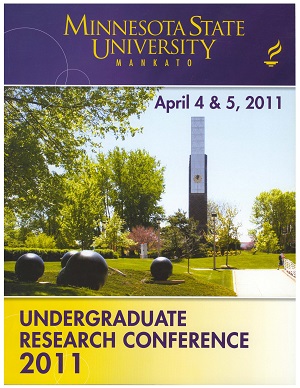Event Title
Exploring Potential Chemopreventive Properties of the Natural Food Derivative Curcumin
Location
CSU 253/4/5
Start Date
4-4-2011 11:00 AM
End Date
4-4-2011 12:30 PM
Student's Major
Chemistry and Geology
Student's College
Science, Engineering and Technology
Mentor's Name
Danae Quirk Dorr
Mentor's Department
Chemistry and Geology
Mentor's College
Science, Engineering and Technology
Description
Curcumin, a derivative of the spice turmeric, has been shown to display several beneficial health properties, including a potential to serve as a chemopreventive agent. It is an ideal research subject for investigating chemopreventive potential because it can be implemented into the diet. This study examined the products of reactions between curcumin and both 2‘-deoxyguanosine (dG) and 2‘-deoxyadenosine (dA). Curcumin was reacted with dG and dA (in separate reaction vessels) in the presence of a phosphate buffer containing L- arginine, as well as in a Tris-HCl buffer. TLC was used to determine which reactions formed products.
Those reaction products were then analyzed using NMR to determine chemical structural features. In addition, calf-thymus DNA (CT-DNA) was reacted with curcumin in a Tris-HCl buffer. After isolation, the treated CT-DNA was digested with various enzymes; the products were isolated with SPE. The dG and dA products and the treated CT-DNA digest were analyzed in sequence using LCMS. The comparison of CT- DNA reaction products and the dG and dA reaction allowed for conclusions to be determined about the ability of curcumin to bind to DNA.
Exploring Potential Chemopreventive Properties of the Natural Food Derivative Curcumin
CSU 253/4/5
Curcumin, a derivative of the spice turmeric, has been shown to display several beneficial health properties, including a potential to serve as a chemopreventive agent. It is an ideal research subject for investigating chemopreventive potential because it can be implemented into the diet. This study examined the products of reactions between curcumin and both 2‘-deoxyguanosine (dG) and 2‘-deoxyadenosine (dA). Curcumin was reacted with dG and dA (in separate reaction vessels) in the presence of a phosphate buffer containing L- arginine, as well as in a Tris-HCl buffer. TLC was used to determine which reactions formed products.
Those reaction products were then analyzed using NMR to determine chemical structural features. In addition, calf-thymus DNA (CT-DNA) was reacted with curcumin in a Tris-HCl buffer. After isolation, the treated CT-DNA was digested with various enzymes; the products were isolated with SPE. The dG and dA products and the treated CT-DNA digest were analyzed in sequence using LCMS. The comparison of CT- DNA reaction products and the dG and dA reaction allowed for conclusions to be determined about the ability of curcumin to bind to DNA.
Recommended Citation
Hamann, Keely. "Exploring Potential Chemopreventive Properties of the Natural Food Derivative Curcumin." Undergraduate Research Symposium, Mankato, MN, April 4, 2011.
https://cornerstone.lib.mnsu.edu/urs/2011/poster-session-B/13



